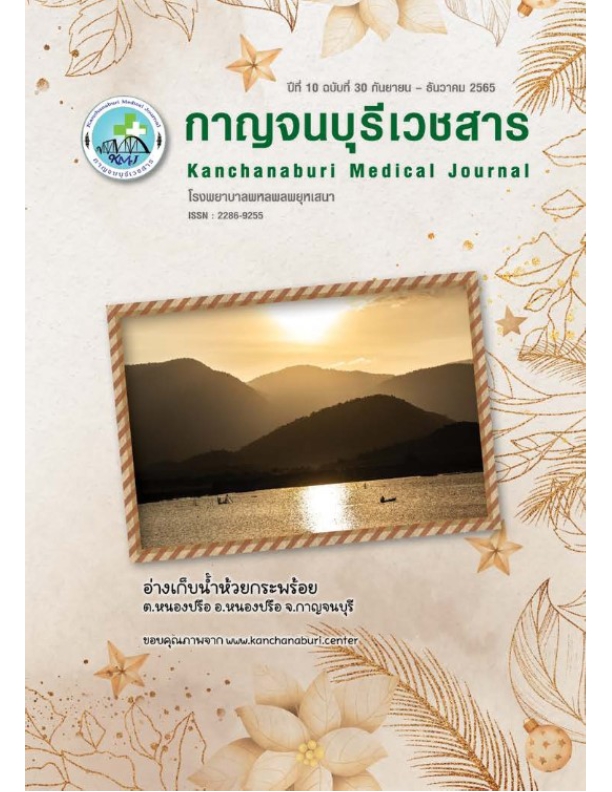Nursing care for mothers after caesarean section with early postpartum hemorrhage : 2 case study
Abstract
Postpartum hemorrhage is the most common birth complication and the leading cause of maternal mortality worldwide. Therefore, nurses caring for mothers in the postpartum period must be knowledgeable and competent in assessing risk factors for postpartum hemorrhageto prevent hemorrhage in the postpartum period. The purpose of this research was to study the nursing care of mothers with postpartum hemorrhage after abdominal cesarean section. Two mothers were compared risk factors, symptoms, signs, medical treatment, nursing diagnoses and nursing outcomes.
The results showed that the 1st case was 35 years old, the first pregnancy was GDMA1, the gestational age was 37+6 weeks, the first pregnancy had premature rupture of membrane, no labor pain, the active phase had no progressionand needed toterminatethe pregnancy by cesarean section. The 2nd case of years old, the first pregnancy, gestational age of 33+4 weeks, had twin pregnancy and preterm labor. At the period of treatment, the labor progress so rapidly then the doctor decided to terminate the pregnancy by caesarean section. From the study, it was found that both mothers had a late postpartum hemorrhagedue to poor contraction of the uterus. There were different risk factors, and the first case had a shock. Both cases had guidelines for caring as follows: assess risk factors for postpartum hemorrhage, evaluate the leading symptoms of postpartum hemorrhagewhen blood lossoccurred,assess uterine contractions, vital signs, signs&symptoms and maintain intravenous fluid, blood and blood componentsand adduterine stimulant drugs according to the doctor's treatment plan rapidly, including explaining the pathology and medical treatment to prepare the postpartum mother for procedures and medical treatment to stop bleeding and alleviate anxiety,using the concept of nursing process to provide nursing care. The results of the study showed that two mothers with late-stage postpartum hemorrhage were safe from the crisis and able to return home to live normally. All this process requires readiness and fast action with the effective team to safe postpartum mothers and minimizing the impact on life and health.
Therefore, professional nurses provide nursing care for mothers in the postpartum period should be competent in assessing risk factors for postpartum hemorrhage,providing immediate and effective nursing care in critical periodtosafe life and protected postpartum mothers from complications.
References
World Health Organization. (2014). WHO guidelines for the management of postpartum hemorrhage and retained placenta. France: WHO Library Cataloguing-in- Publication Data.
กรมอนามัย-กระทรวงสาธารณสุข. (2563). สถิติการตายและสาเหตุการตายของมารดาทั่วประเทศไทย. http://dashboard.anamai.moph.go.th.
สำนักนโยบายและยุทธศาสตร์ สำนักงานปลัดกระทรวงสาธารณสุข กระทรวงสาธารณสุข. (2562). สถิติสาธารณสุข พ.ศ.2562. นนทบุรี.
สำนักส่งเสริมสุขภาพ กรมอนามัย กระทรวงสาธารณสุข.(2564). อัตราส่วนการตายมารดาไทย.
http://healthkpi.moph.go.th/kpi2/kpi/index/?id=1409.
ราชวิทยาลัยสูตินรีแพทย์แห่งประเทศไทย. (2563). แนวทางเวชปฏิบัติ เรื่อง การป้องกันและรักษาภาวะตกเลือดหลังคลอด.
http://www.rtcog.or.th/home/wp- Content/uploads/2020/09/OB-63-020-Prevention-and-Management-o-fPostpartum-Hemorrhage.pdf.
Florida Perinatal Quality Collaborative. (2015). Florida Obstetric Hemorrhage Initiative Toolkit: A Quality Improvement Initiative for Obstetric Hemorrhage Management.
Carroll, M., Daly, D. and Begley, C.M. (2016). The prevalence of women’s emotional and physical health problems following a postpartum hemorrhage: asystematicreview. BMC Pregnancy and Childbirth,16(1), 261.
ปทุมมา กังวานตระกูล, อ้อยอิน อินยาศรี. (2560). การพัฒนาแนวปฏิบัติการพยาบาลเพื่อป้องกันการตกเลือดในระยะ 2 ชั่วโมงแรกหลังคลอดในห้องคลอดโรงพยาบาลอุดรธานี.วารสารวิทยาลัยพยาบาลบรมราชชนนี, 33(2), 121-133.
Lim, P.S. (2012). Uterine Atony: Management Strategies. from: https://www.intechopen.com./
จิราวัลณ์ วินาลัยวนากูล. (2561). ภาวะผิดปกติที่พบบ่อยในระหว่างการคลอด: การนำไปใช้ในการสอนนักศึกษาพยาบาล.วารสารพยาบาลศาสตร์ มหาวิทยาลัยสยาม, 19(37), 135-147.
Abraham, W. & Berhan, Y. (2014).Predictors of labor abnormalities in university hospital : unmatched case control study. BMC Pregnancy and Childbirth. 14(256): 1-11. Retrieved March 19, 2018, from: http://www.biomedcentral.com/1471-2393/14/256
สมพร เฮงประเสริฐ.(2563). กรณีศึกษา:การพยาบาลมารดาหลังผ่าตัดคลอดทางหน้าท้อง เนื่องจากมีความดันโลหิตสูงขณะตั้งครรภ์ชนิดรุนแรง และตั้งครรภ์แฝด ร่วมกับมีภาวะตกเลือดหลังคลอด.วารสารวิทยาลัยพยาบาลพระจอมเกล้า จังหวัดเพชรบุรี, 2(3), 75-93.
Downloads
Published
How to Cite
Issue
Section
License
Copyright (c) 2022 Phaholpolpayuhasena Hospital

This work is licensed under a Creative Commons Attribution-NonCommercial-NoDerivatives 4.0 International License.
บทความที่ได้รับการตีพิมพ์เป็นลิขสิทธิ์ของโรงพยาบาลพหลพลพยุหเสนา
ข้อความที่ปรากฏในบทความแต่ละเรื่องในวารสารวิชาการเล่มนี้เป็นความคิดเห็นส่วนตัวของผู้เขียนแต่ละท่านไม่เกี่ยวข้องกับโรงพยาบาลพหลพลพยุหเสนาและบุคลากรท่านอื่น ๆ ในโรงพยาบาลฯ แต่อย่างใด ความรับผิดชอบองค์ประกอบทั้งหมดของบทความแต่ละเรื่องเป็นของผู้เขียนแต่ละท่าน หากมีความผิดพลาดใด ๆ ผู้เขียนแต่ละท่านจะรับผิดชอบบทความของตนเอง



 Phaholpolpayuhasena Hospital
Phaholpolpayuhasena Hospital
